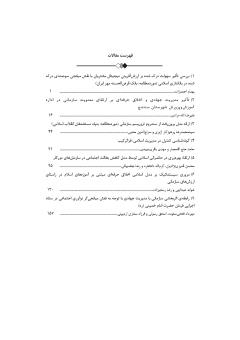بررسی تاثیر سهولت درک شده بر ارزش آفرینی دیجیتال مشتریان با نقش میانجی سودمندی درک شده در بانکداری اسلامی (مورد مطالعه: بانک قرض الحسنه مهر ایران)
محورهای موضوعی : مدیریت جهادی
1 - گروه مدیریت بازاریابی، واحدبابل، دانشگاه آزاد اسلامی، بابل، ایران
کلید واژه: بانکداری اسلامی, سهولت درک شده, سودمندی درک شده, ارزش آفرینی دیجیتال,
چکیده مقاله :
هدف از ارائه مقاله تعیین تأثیر سهولت درک شده بر ارزشآفرینی مشتریان با نقش میانجی سودمندی درک شده در بانکداری اسلامی، میباشد. جامعه آماری پژوهش حاضر متشکل از مشتریان ثابت و آنلاین بانک قرضالحسنه مهر ایران استان مازندران میباشد بهطورکلی جامعه آماری نامحدود و با توجه به جدول مورگان، تعداد نمونه 384 نفر میباشد و روش نمونهگیری بهصورت غیر احتمالی در دسترس و با پرسشنامه طیف لیکرت از آنها نظرسنجی شده است. تجزیهوتحلیل دادهها برای بررسی آزمون فرضیات با استفاده از روش معادلات ساختاری به کمک نرمافزار PLS Smart انجام شد. بهمنظور سنجش روایی پرسشنامه از آزمون AVE که مقدار آن برای تمامی متغیرها بالاتر از 0.5 تائید گردید و همچنین جهت تعیین پایایی پرسشنامه از آلفا کرونباخ و پایایی مرکب که مقدار هر دو آزمون بیشتر از 0.7 تائید شده است. نتایج نشان میدهد که 1- سهولت درک شده بر ارزشآفرینی مشتریان تأثیر مثبت و معنادار دارد، 2- سهولت درک شده بر سودمندی درک شده تأثیر مثبت و معنادار دارد، 3- سودمندی درک شده بر ارزشآفرینی مشتریان تأثیر مثبت و معنادار دارد. 4- با توجه به آزمون سوبل سهولت درک شده بر ارزشآفرینی مشتریان با نقش میانجی سودمندی درک شده در بانکداری اسلامی تأثیر مثبت و معناداری دارد.
The purpose of presenting the article is to determine the effect of perceived ease on customer value creation with the mediating role of perceived usefulness in Islamic banking. The statistical population of the present study consists of regular and online customers of Qarz Al-Hasneh Mehr Bank of Iran, Mazandaran province. In general, the statistical population is unlimited and according to Morgan's table, the sample number is 384, and the sampling method is non-probability and with spectrum questionnaire. They have been polled on a Likert scale. Data analysis was done to test hypotheses using structural equation method with the help of PLS Smart software. In order to measure the validity of the questionnaire from the AVE test, the value of which was confirmed above 0.5 for all variables, and also to determine the reliability of the questionnaire from Cronbach's alpha and composite reliability, the value of both tests was confirmed to be more than 0.7. The results show that 1- Perceived ease has a positive and meaningful effect on customers' value creation, 2- Perceived ease has a positive and meaningful effect on perceived usefulness, 3- Perceived usefulness has a positive and meaningful effect on customers' value creation.
1) اسماعیلی، مهرداد؛ طلوعی اشلقی، عباس؛ پورابراهیمی، علیرضا؛ اسمعیلی، رقیه (1396) بررسی میزان پذیرش و امکان پیادهسازی فناوری اطلاعات در کارکنان دانشگاه علوم پزشکی شهید بهشتی بر اساس مدل دیویس (TAM)، دوماهنامه پژوهشی پژوهنده، 18، 1، 40-45.
2) تباوار، ع. ا. دهقانی، م. & مرعشی، ب (1398). شناسایی فرصتهای بهبود تجربه مشتری از طریق بانکداری دیجیتال. نخستین کنفرانس ملی مدیریت، اخلاق و کسبوکار.
3) حیدرزاده اقدم، نرجس، شاهوردیانی، شادی، تبریزیان، بیتا. (1400). ارائه الگوی مدیریت ریسک در بانکداری دیجیتال رویکرد عقلانی، فصلنامه علمي پژوهشي دانش سرمایهگذاری، سال دهم، شماره سي وهفتم، صص 489-515.
4) رابطی، رئوف، (1393). بانکداری شرکتی و ارزشآفرینی برای مشتریان، سازمان برتر، شماره 10، صص 56-62.
5) سرلک، محمدعلی؛ روستایی، محمد، مقدسیان، محمدحسین. (1391). عوامل مؤثر بر پذیرش بانکداری از طریق تلفن همراه در ایران، چهارمین کنفرانس بینالمللی بازاریابی خدمات بانکی، صص
1-21.
6) کاظمیان، محسن، حبیبی، علیرضا، حبیبی، مرتضی. (1399). بررسی میزان تأثیر سهولت استفاده، سودمندی درک شده و تصویر اجتماعی استفاده از موبایل بانک بر نگرش مشتریان و تمایل مشتریان به استفاده (موردمطالعه: استفادهکنندگان موبایل بانک تجارت)، فصلنامه رویکردهای پژوهشی نوین در مدیریت و حسابداری، سال چهارم، شماره 28، جلد دوم، صص 74-93.
7) Alcantara, J. M. (2012). Modelización del comportamiento del con-sumidor online. El papel moderador de la cultura, el disenoweb y el idioma. Tesis. Departamento de Comercialización eInvestigación de Mercados, Universidad de Granada.
8) Bachoo, T. (2017). Analysis of the Key Success Factors of the Adoption of Digital Banking: Case of Mauritius. GRIN Verlag.
9) Bömer, M. & Maxin, H. (2018). Why fintechs cooperate with banks—evidence from germany. Zeitschrift Für Die Gesamte Versicherungswissenschaft, 107(4), 359–386.
10) Carranza, R. Díaz, E, Sánchez-Camacho, C. Martín-Consuegra, D. (2021) e-Banking Adoption: An Opportunity for Customer Value Co-creation, Frontiers in Psychology, www.frontiersin.org, 10.3389/fpsyg.2020.621248
11) Celik, H. (2011). Influence of social norms, perceived playfulness and online shopping anxiety on customers adoption of online retail shopping. International Journal of Retail and Distribution Management, 39(6), 390-413
12) Ito, J. Narula, N. & Ali, R. (2017). The Blockchain Will Do to the Financial System What the Internet Did to Media. Harvard Business Review, Digital Article.
13) Kelman, J. (2016). The History of Banking: A Comprehensive Reference Source & Guide. Create Space Independent Publishing Platform.
14) Munoz-Leiva, F. Hernández-Méndez, J. & Sánchez-Fernández, J. (2012). Generalising user behaviour in online travel sites throughthe Travel 2.0 website acceptance model. Online InformationReview, 36(6), 879-902.
15) Puschmann, T. (2017). Fintech. Business & Information Systems Engineering, 59(1), 69–76.
16) Scardovi, C. (2017). Digital Transformation in Financial Services. Springer.

